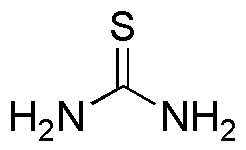Thiourea is widely utilized in research focused on:
- Agriculture: It serves as a nitrogen source in fertilizers, promoting plant growth and improving crop yields.
- Pharmaceuticals: Used in the synthesis of various drugs, thiourea plays a crucial role in developing treatments for conditions like diabetes and cancer.
- Analytical Chemistry: Thiourea acts as a reagent in various analytical methods, aiding in the detection and quantification of metals and other compounds.
- Textile Industry: It is employed in dyeing processes to enhance color fastness and improve the overall quality of fabrics.
- Electroplating: Thiourea is used in electroplating baths to produce high-quality metal coatings, offering better adhesion and corrosion resistance.
General Information
Properties
Safety and Regulations
Applications
Thiourea is widely utilized in research focused on:
- Agriculture: It serves as a nitrogen source in fertilizers, promoting plant growth and improving crop yields.
- Pharmaceuticals: Used in the synthesis of various drugs, thiourea plays a crucial role in developing treatments for conditions like diabetes and cancer.
- Analytical Chemistry: Thiourea acts as a reagent in various analytical methods, aiding in the detection and quantification of metals and other compounds.
- Textile Industry: It is employed in dyeing processes to enhance color fastness and improve the overall quality of fabrics.
- Electroplating: Thiourea is used in electroplating baths to produce high-quality metal coatings, offering better adhesion and corrosion resistance.
Documents
Safety Data Sheets (SDS)
The SDS provides comprehensive safety information on handling, storage, and disposal of the product.
Product Specification (PS)
The PS provides a comprehensive breakdown of the product’s properties, including chemical composition, physical state, purity, and storage requirements. It also details acceptable quality ranges and the product's intended applications.
Certificates of Analysis (COA)
Search for Certificates of Analysis (COA) by entering the products Lot Number. Lot and Batch Numbers can be found on a product’s label following the words ‘Lot’ or ‘Batch’.
*Catalog Number
*Lot Number
Certificates Of Origin (COO)
This COO confirms the country where the product was manufactured, and also details the materials and components used in it and whether it is derived from natural, synthetic, or other specific sources. This certificate may be required for customs, trade, and regulatory compliance.
*Catalog Number
*Lot Number
Safety Data Sheets (SDS)
The SDS provides comprehensive safety information on handling, storage, and disposal of the product.
DownloadProduct Specification (PS)
The PS provides a comprehensive breakdown of the product’s properties, including chemical composition, physical state, purity, and storage requirements. It also details acceptable quality ranges and the product's intended applications.
DownloadCertificates of Analysis (COA)
Search for Certificates of Analysis (COA) by entering the products Lot Number. Lot and Batch Numbers can be found on a product’s label following the words ‘Lot’ or ‘Batch’.
*Catalog Number
*Lot Number
Certificates Of Origin (COO)
This COO confirms the country where the product was manufactured, and also details the materials and components used in it and whether it is derived from natural, synthetic, or other specific sources. This certificate may be required for customs, trade, and regulatory compliance.


